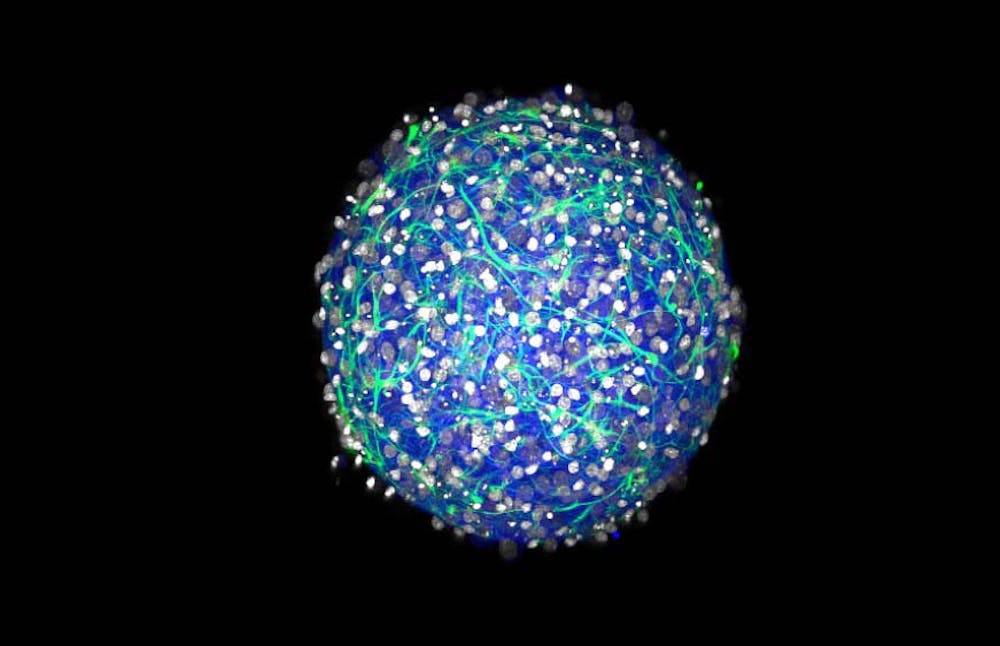University researchers have found a way to grow a brain in a Petri dish. About a third of a millimeter in diameter, these “mini-brains” are composed of neurons and supporting cells that form synaptic connections and produce complex networks. They have a three-dimensional, spherical shape known as a spheroid and achieve a cellular density similar to that of a normal rodent brain.
“These spheroids are actually a step closer in biological function to real organs and tissues, but they’re cheaper and faster,” said Jeffrey Morgan, professor of engineering and medical science, co-director of the Center for Biomedical Engineering and a coauthor of the study.
Mass production of these spheroids of neural tissue will help researchers study neurological disorders, brain injuries, toxicity and drug efficacy, according to the paper, which was published online Oct. 6 in the journal Tissue Engineering Part C: Methods.
“There are so many ideas floating around in science, and some of the best ideas are high-risk and high-reward,” said Diane Hoffman-Kim, associate professor of medical science and engineering and the corresponding author of the study.
“We’ve developed a platform where you can test out a lot of these ideas at once and compare the results,” she said.
The mini-brains contain a diverse array of cells including neurons, neural stem cells and glial cells, which are support cells. Cells in the tissue produce their own extracellular matrix — a scaffolding that provides structure and affects cell differentiation — creating an external layer that mimics the “squishiness” of a normal brain, Hoffman-Kim said.
In contrast to most cell cultures, the mini-brains are grown in a unique three-dimensional Petri dish developed by Morgan, who commercialized the engineering mold when he founded MicroTissues Inc. in 2009.
The researchers dissected rats within two days after their birth and extracted parts of their brains, said Molly Boutin GS, the study’s co-lead author. “You can take that chunk of tissue and break it into single cells and then put those cells into three-dimensional molds. When they fall into the wells of the Petri dishes, they self-assemble and form little spheres,” she said.
This small sample of living tissue from a rodent can produce thousands of these spheroids at an approximate cost of $0.25 per mini-brain, according to the University press release.
Unlike normal brains, the spheres of neural tissue do not have a blood supply. Instead, they are placed in a medium rich with vitamins and nutrients. Because the brains are so small in size, oxygen can diffuse into their centers, Hoffman-Kim said.
This feature of the mini-brains may allow researchers to use them to study strokes. “Strokes are very common in adults and result in a lack of oxygen and nutrient diffusion into the brain. We’ve tried to mimic this in vitro in a lab setting,” Boutin said.
To simulate a stroke, the researchers can remove the oxygen supply to a particular chamber of the mini-brain or put the brain into a different medium that lacks the required nutrients, Boutin said. By adding soluble drugs into the cell media, researchers can also test the effectiveness of new drug treatments before conducting clinical trials. This may reduce the amount of animal testing, Hoffman-Kim said.
The 3-D mini-brains are “novel” because of their depth and shape, wrote Barry Connors, professor and chair of the Department of Neuroscience, in an email to The Herald. The brains “might be useful for studying the movement of molecules like drugs, nutrients and transmitter molecules through the complex matrix of brain cells,” he added.
“And perhaps most interesting of all, they could be a good place to study the molecular signals that allow neurons to develop and hook up into the sort of organized circuits that comprise real brains,” he wrote.
Some individuals have contacted the researchers with ethical inquiries, Hoffman-Kim said. But people should not worry, as “these brains are for sure not thinking — they’re super simple,” she said.
“As a scientist, as I get more mature, I’m in awe of how complex the brain is.,” Hoffman-Kim added. “These mini-brains just don’t approximate that complexity.”





